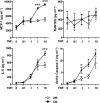Vascular endothelial cells cultured from patients with cerebral or uncomplicated malaria exhibit differential reactivity to TNF
- PMID: 21029292
- PMCID: PMC3041929
- DOI: 10.1111/j.1462-5822.2010.01528.x
Vascular endothelial cells cultured from patients with cerebral or uncomplicated malaria exhibit differential reactivity to TNF
Abstract
Plasmodium falciparum malaria is a major cause of morbidity and mortality in African children, and factors that determine the development of uncomplicated (UM) versus cerebral malaria (CM) are not fully understood. We studied the ex vivo responsiveness of microvascular endothelial cells to pro-inflammatory stimulation and compared the findings between CM and UM patients. In patients with fatal disease we compared the properties of vascular endothelial cells cultured from brain tissue to those cultured from subcutaneous tissue, and found them to be very similar. We then isolated, purified and cultured primary endothelial cells from aspirated subcutaneous tissue of patients with CM (EC(CM) ) or UM (EC(UM) ) and confirmed the identity of the cells before analysis. Upon TNF stimulation in vitro, EC(CM) displayed a significantly higher capacity to upregulate ICAM-1, VCAM-1 and CD61 and to produce IL-6 and MCP-1 but not RANTES compared with EC(UM) . The shedding of endothelial microparticles, a recently described parameter of severity in CM, and the cellular level of activated caspase-3 were both significantly greater in EC(CM) than in EC(UM) . These data suggest that inter-individual differences in the endothelial inflammatory response to TNF may be an additional factor influencing the clinical course of malaria.
© 2010 Blackwell Publishing Ltd.
Figures






References
-
- Beekhuizen H, Corsel-van Tilburg AJ, van Furth R. Characterization of monocyte adherence to human macrovascular and microvascular endothelial cells. J Immunol. 1990;145:510–518. - PubMed
-
- Belloni PN, Carney DH, Nicolson GL. Organ-derived microvessel endothelial cells exhibit differential responsiveness to thrombin and other growth factors. Microvasc Res. 1992;43:20–45. - PubMed
-
- Berendt AR, Tumer GD, Newbold CI. Cerebral malaria: the sequestration hypothesis. Parasitol Today. 1994;10:412–414. - PubMed
Publication types
MeSH terms
Substances
Grants and funding
LinkOut - more resources
Full Text Sources
Research Materials
Miscellaneous

